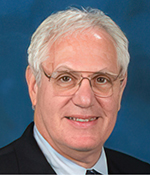
Editor’s note: The Final Cut is a recurring editorial series written by a member of the AAOS Now Editorial Board.
The big pot on the stove—was it soup or syringes? From my angle, as a 5-year-old, I couldn’t tell. A few sniffs would reveal the answer: Mom had made chicken soup, a therapeutic liquid that could cure respiratory and gastrointestinal ailments more reliably than Vicks VapoRub or castor oil. On other days, however, with no reassuring fragrance, the pot looked different, with black knobs around the rim, tightly securing the lid. During those times, my mother was sterilizing glass syringes and metal needles for my father’s orthopaedic practice.
During the years immediately after World War II, dad was the only board-certified orthopaedic surgeon in Queens County, New York. The first floor of our Forest Hills home served as his office; my younger sister and I entered the house through the kitchen door, stove on the right, refrigerator straight ahead. Terrified of needles, my sister ran upstairs to her bedroom whenever mom removed implements from the autoclave pot.
My father’s practice soon outgrew his one-exam-room office, so he moved it to a building on Queens Boulevard, restoring our living room and dining room to match other homes on the block. Dad bought a new front-loading autoclave and continued to reuse needles and syringes until the tradition fell out of fashion.
Dad’s glass syringes had a metal hub called a Leur lock, which secured the needle to the syringe. The lock was originally invented in France in 1896 for the H. Wulfing Leur Company. Fairleigh S. Dickinson, co-founder of Becton Dickinson, modified the design in 1930 by adding flanges that prevented a needle from popping off a pressurized syringe. These fittings became the industry standard and are still used today.
In 1955, the Roehr Monoject became the world’s first disposable plastic syringe. In response, Becton Dickinson developed the disposable Plastipak syringe a few years later. These products failed to displace reusable glass syringes and needles, which had a good safety and economy record. However, all this changed on Dec. 19, 1961, when Albert Weiner, DO, was convicted of transferring fatal hepatitis to 12 patients via unsterilized glass needles and syringes. Within a year, plastic syringes had captured one-third of the injection device market in the United States. For the next two decades, single-use needles and syringes gradually replaced reusable injection equipment as doctors and hospital administrators saw labor cost savings by relying on disposable healthcare products.
On June 5, 1981, the Centers for Disease Control and Prevention published a report on five gay men who acquired a rare, fatal pulmonary infection caused by Pneumocystis carinii, marking the beginning of the AIDS epidemic in the United States. Soon, disposable syringes and needles became the standard of care, primarily to protect healthcare workers from HIV and hepatitis viruses. Advocates for IV drug users encouraged single-use delivery products as well for the same reasons.
In August 1987, the “syringe tide” hit at the height of the tourist season; used syringes and needles—some containing bodily fluids—washed up on the beaches of New Jersey. The furious Garden State governor instructed New Jersey’s U.S. attorney, Samuel Alito, to commence legal action against New York City, implying that the contaminated items originated from a massive garbage dump on Staten Island, an assertion Mayor Ed Koch strongly denied. Nevertheless, a floating “superboom” soon stretched across the ocean bordering the garbage dump to stop items from floating toward New Jersey. It didn’t help.
The following year, the syringe tide extended along the entire eastern seaboard of the United States, periodically closing beaches during the mid-summer. In response, Congress enacted and President Ronald Reagan signed the Medical Waste Tracking Act of 1988, which required monitoring of disposed bodily fluids and contaminated medical products. The Congressional act expired in 1991.
Other syringe tides followed, including one landing on the shores of Lake Erie in 1988 and another at Newport Beach, California, in 2017. To make matters worse, in public parks and at encampments of unhoused persons around the country, plastic-hub needles and plastic syringes supplied for one-time use to injecting drug users appeared on sidewalks and lawns at a rate faster than cleanup crews could remove them.
Nowadays, managing medical waste constitutes one of healthcare’s most costly line items. Such products must be categorized as radioactive waste; sharps; blood, bodily fluid, and tissue waste; microbiological waste; pharmaceutical waste; research laboratory waste products; and so forth. Finding vendors to remove these products from hospitals, surgery centers, and doctors’ offices is a challenge, especially as municipalities suffering from increasing air, water, and land pollution restrict the kinds of waste that can be successfully neutralized within their boundaries. Perhaps my folks had it right when they steam-sterilized reusable items after carefully cleaning and disinfecting them, inside and out.
Stuart A. Green, MD, FAAOS, is cofounder and past president of the Limb Lengthening and Reconstruction Society; past president of the Association of Bone and Joint Surgeons; and a clinical professor of orthopaedic surgery at the University of California, Irvine. He is the son, first cousin, and father of AAOS Fellows. Dr. Green is a member of the AAOS Now Editorial Board.